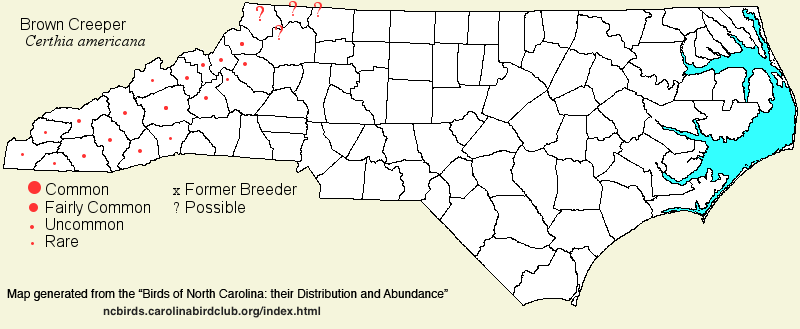 |  |
|
Brown Creeper - Certhia americana Sole representative of CERTHIIDAE in NC | Search Common: Search Scientific: |
|
|
|||||||
| General Comments | The Brown Creeper is a unique bird in the Western Hemisphere; the other members of this small family occur in the Old World. It nests and winters from coast to coast, though it is highly migratory. In our state, it nests in the middle and higher elevations of the mountains; it winters statewide. As it nests essentially only beneath loose bark on tree trunks -- no other North American bird does that -- it requires mature forests, usually spruce-fir, but also in mixed forests, as long as the micro-climate is cool. In winter, they almost always occur in mixed species flocks led by chickadees and titmice, foraging through a variety of forests and woodlands, favoring a mix of pines and hardwoods. Creepers spiral upwards along tree trunks, usually staying on the shady side of the trunk, and then after a minute or two on one tree, fly down toward the base of another tree. Though nesting populations appear somewhat stable over the decades, for whatever reason this and a few other "spruce-fir" nesters have occupied sites well below that zone in the breeding season in recent years. | ||||||
| Breeding Status | Breeder | ||||||
| NC BRC List | Definitive | ||||||
| State Status | SC | ||||||
| U.S. Status | |||||||
| State Rank | S3B,S5N | ||||||
| Global Rank | G5 | ||||||
| Coastal Plain | Winter resident. In winter, fairly common (but quiet and easily overlooked) in the western half of the province, uncommon to fairly common in the Tidewater zone, but uncommon in the coastal and southeastern areas. Along the Outer Banks, most numerous in fall, decreasing in winter. Mainly early Oct to late Mar or very early Apr. Peak counts: | ||||||
| Piedmont | Winter resident. Fairly common (but quiet and easily overlooked) over most of the province. Mainly mid-Oct to early Apr. One at Greensboro on 16 Aug 2001 was quite out of season. Peak counts: | ||||||
| Mountains | Breeder at higher elevations, and winter resident. Uncommon and somewhat local as a breeder, mainly above 4,500 feet; less numerous down to about 3,000 feet in a few cool micro-climates. In winter, uncommon to locally fairly common at low elevations, less common in middle elevations. Winter birds arrive in early Oct and depart by early or mid-Apr. Peak counts: | ||||||
| Finding Tips |
The species is quite widespread, but it occurs in fairly low density, across most of the state in winter. Most parks and refuges hold a few; look and listen carefully in the chickadee flocks. In the breeding season, Mount Mitchell SP, and the Blue Ridge Parkway between Richland Balsam and Devils Courthouse, are places to look and listen for them. *** | ||||||
| Attribution | LeGrand[2023-03-27], LeGrand[2012-09-16], LeGrand[2011-12-11] | ||||||
| NC Map Map depicts all counties with a report (transient or resident) for the species. | Click on county for list of all known species. |
| NC Breeding Season Map Map depicts assumed breeding season abundance for the species. |  |